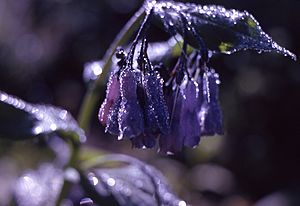Tall fringed bluebells facts for kids
Quick facts for kids Tall fringed bluebells |
|
|---|---|
 |
|
| Scientific classification | |
| Genus: |
Mertensia (plant)
|
| Species: |
ciliata
|
Mertensia ciliata is a beautiful flowering plant. It is part of the borage family. People often call it tall fringed bluebells, mountain bluebells, or streamside bluebells.
Contents
Where It Grows
This plant naturally grows in the western United States. You can find it in California, Nevada, Utah, and Oregon. It loves places that are wet. This includes mountain meadows and areas next to creeks. Sometimes, it covers huge parts of meadows and hillsides. It makes these areas look blue-green with its leaves and sweet-smelling bluebell flowers.
What It Looks Like
Plant Parts
Mertensia ciliata is a perennial herb. This means it lives for more than two years. It grows many straight stems from a thick, branching base called a caudex. These leafy stems can grow very tall, sometimes over a meter (about 3 feet). The leaves are shaped like ovals or spears. They have clear veins and come to a point.
Beautiful Bluebell Flowers
The flowers grow in an open group called an inflorescence. There are many blue, bell-shaped flowers in each cluster. Each flower is about 1 to 2 centimeters long. They hang down and have a sweet smell. The flower starts as a tube and then opens wider at the end. As the flowers get older, their color changes. They go from blue to a pink-red color.
How Bluebells Get Pollinated
The flowers of Mertensia ciliata have special parts called anthers. These anthers release pollen through small pores. This plant needs a special way of pollination called buzz-pollination. This is when insects, like certain types of bumblebees (Bombus species), shake the flower. They vibrate their flight muscles to make the pollen fall out.
Sometimes, bumblebees will "nectar rob" these flowers. This means they take the sweet nectar without helping to pollinate the plant. They might bite a hole in the side of the flower. This is common with some bumblebee types, like the Bombus occidentalis.
Uses
You can eat parts of the Mertensia ciliata plant. The flowers, young stems, and young leaves can be eaten raw. Older leaves tend to be hairy, so it's better to cook them. The plant contains natural chemicals called alkaloids. Because of this, you should not eat very large amounts of it.

